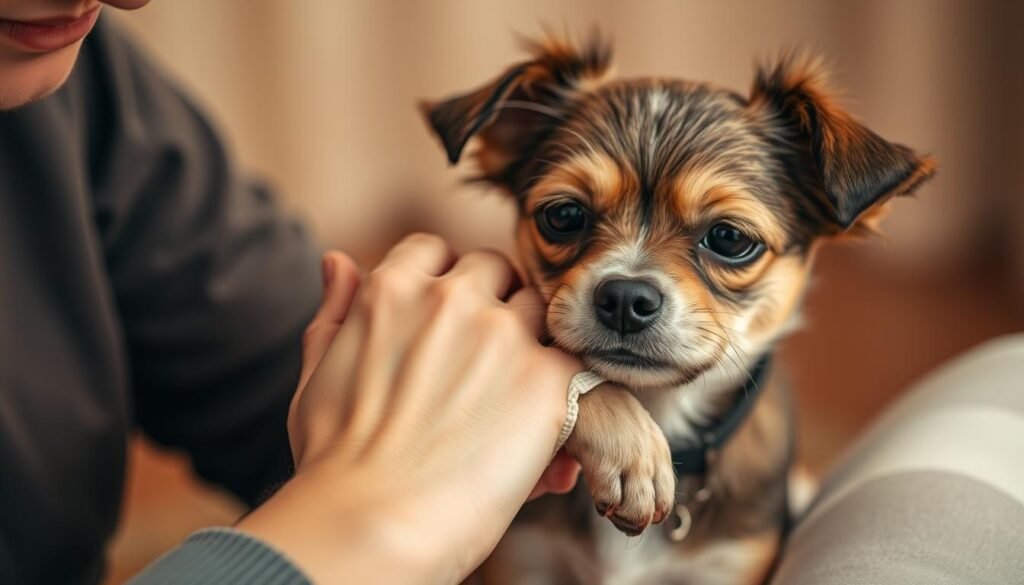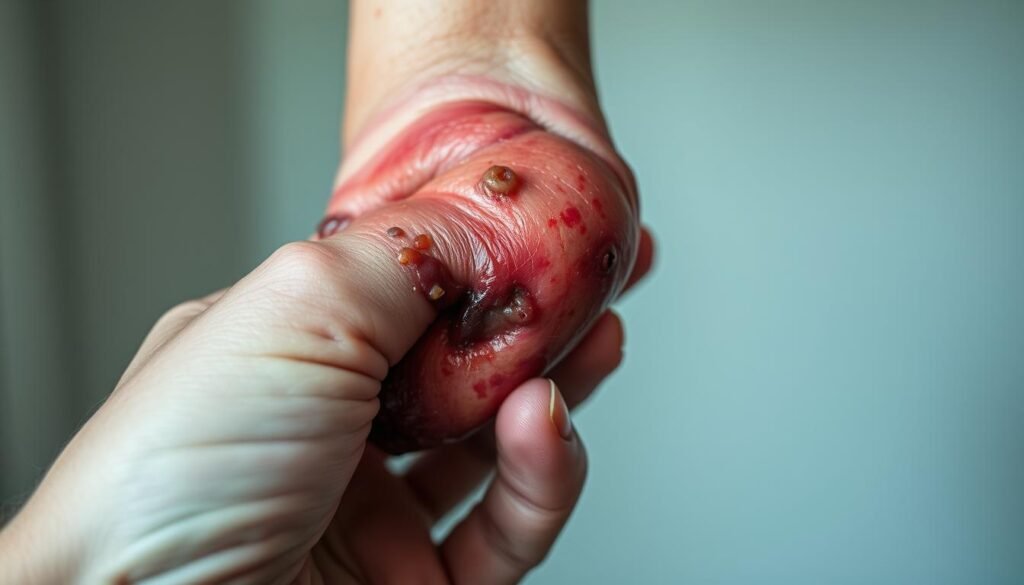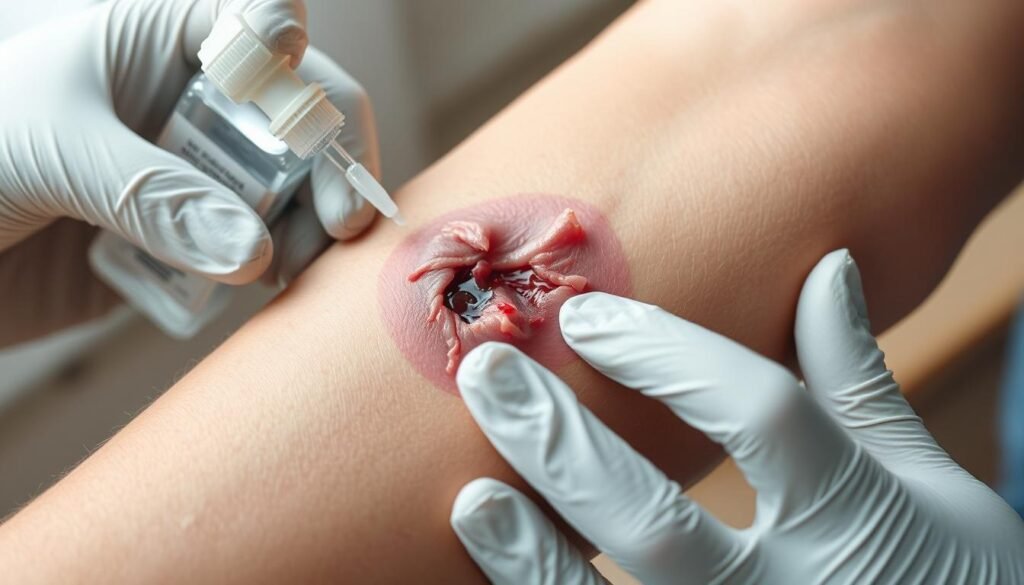As a dog owner, it’s crucial to know how to treat a dog bite. This ensures your pet stays healthy and safe. Dog bites can be serious, and knowing how to act can be a lifesaver. This article will guide you through treating dog bites, from the first steps to preventing future incidents.

Introduction to Dog Bite Care
Dog bite care involves several steps to help your dog heal. It’s important to treat the bite right to avoid infections and scarring. By following the right steps, you can help your dog recover fast and avoid long-term problems.
Key Takeaways
- Proper dog bite treatment is essential for preventing infection and promoting healing
- Immediate actions, such as separating the dogs and assessing the severity of the bite, are critical
- Wound care, including cleaning and disinfecting, is vital for preventing infection
- Prevention of future incidents, such as training and socialization, can help reduce the risk of dog bites
- Seeking medical attention immediately if you notice signs of infection or other complications
- Dog bite care involves a series of steps to promote healing and minimize scarring
Immediate Actions After a Dog Bite
If a dog bites you, safety is key. The first thing to do is separate the dogs. This step is vital to prevent more harm and to figure out how serious the bite is.
After you’ve separated the dogs, check how bad the bite is. Look at the size and depth of the wound. Also, watch for any signs of infection. The American Veterinary Medical Association (AVMA) has guidelines to help you understand the severity of the bite.
Safety Precautions
- Separate the dogs immediately to prevent further injury
- Wash the wound with soap and water to prevent infection
- Apply a clean bandage to the wound to protect it
If the bite is severe or the dog seems aggressive, call emergency services right away. This is a serious situation that needs quick help. Taking these steps can help avoid more problems and ensure the best outcome.
Acting fast is crucial to handle a dog bite safely. By following these steps, you can make sure a dog bite is handled correctly and effectively.
What to Put on a Dog Bite from Another Dog
When dealing with a dog bite, dog bite wound care is crucial. The American Kennel Club (AKC) suggests cleaning the wound with mild soap and water. Then, apply an antiseptic solution to prevent infection and aid in healing.
It’s important to watch the wound for signs of infection. Look for redness, swelling, or discharge. These could mean the wound is not healing properly.
Here are some steps to follow for proper dog bite wound care:
- Clean the wound with mild soap and water
- Apply an antiseptic solution to prevent infection
- Monitor the wound for signs of infection, such as redness, swelling, or discharge
Proper dog bite treatment is vital to avoid infection and help the wound heal. Always focus on dog bite wound care. If you see any signs of infection, seek medical help right away.
Cleaning and Disinfecting the Wound
Proper dog bite cleaning and dog bite disinfecting are key steps in treating a dog bite. The Centers for Disease Control and Prevention (CDC) says wound care is vital to prevent infection and help it heal. The aim is to clean the wound well without making it worse.
To begin the dog bite cleaning process, rinse the wound with mild soap and water. This removes any debris or bacteria that might have gotten in. Then, apply an antiseptic solution, like hydrogen peroxide or iodine, to lower the risk of infection. It’s important to be gentle when dog bite disinfecting to avoid harming the wound further.
Some important things to remember when cleaning and disinfecting a dog bite include:
- Avoid harsh chemicals or abrasive materials, as they can irritate the wound and slow healing.
- Don’t press too hard, as this can push bacteria and debris deeper into the wound.
- Keep the wound moist to help it heal faster and reduce scarring.
By following these steps and using the right dog bite cleaning and dog bite disinfecting methods, you can prevent infection and aid healing. Always prioritize gentle care and follow the CDC’s guidelines for wound care for the best results.
Signs of Infection to Watch For
After a dog bite, it’s key to watch the wound for dog bite infection signs. The Mayo Clinic says to look for redness, swelling, or discharge. Other signs include more pain, fever, or a bad smell from the wound.
If you see these signs, get vet care right away. Dog bite infection can cause serious problems like abscesses or blood infections. Spotting infection early helps avoid these issues and aids in healing.

- Increased redness or swelling around the wound
- Pus or discharge from the wound
- A foul odor from the wound
- Increased pain or tenderness around the wound
- Fever or chills
Knowing these dog bite symptoms and getting medical help when needed helps in a quick recovery from a dog bite.
Medical Treatment Options
Seeking professional help is key for dog bite treatment. The American Animal Hospital Association (AAHA) says treatment can vary. Sometimes, stitches are needed for deep or big wounds.
A doctor will check the wound and decide the best treatment. This might include antibiotics to fight infection. They might also give pain and swelling medicines. It’s important to stick to the treatment plan for healing and to avoid problems.
- Wound cleaning and disinfection
- Stitching or suturing the wound
- Applying topical antibiotics
- Prescribing oral antibiotics
- Rabies prevention protocol, which may include vaccination and observation
Getting medical help quickly and following the treatment plan helps avoid infection. Always let a healthcare expert guide your treatment for the best results.
Home Care and Wound Management
Proper dog bite home care is key for healing and avoiding infection. PetMD says watching the wound for signs of infection is important. These signs include redness, swelling, or more pain than usual. Keeping the wound clean and dry stops bacteria from growing and helps it heal.
For dog bite wound management, there are important steps. Use topical ointments or creams to help it heal. Also, cover the wound with a bandage to protect it. Remember to change the bandage often to keep it clean and dry.

- Monitoring the wound for signs of infection
- Keeping the wound clean and dry
- Applying topical ointments or creams to promote healing
- Keeping the wound covered with a bandage to protect it from further irritation
By following these tips, you can help the wound heal and avoid infection. Always talk to a medical professional if you have concerns about dog bite wound management or dog bite home care.
Legal Considerations and Documentation
When a dog bites, it’s key to think about the legal side and document everything well. You should report the incident to the police and start the insurance claim process. The Insurance Information Institute (III) says dog bite claims can be tricky. So, it’s important to document everything right.
Understanding your state’s laws about dog bites is crucial. You also need to collect evidence like photos of the injury, witness statements, and more. This evidence helps a lot when you’re documenting the incident. You might need to file a report with the police or animal control.
Here are some steps to document a dog bite:
- Report the incident to local authorities
- Gather evidence, such as photos and witness statements
- Get medical attention and keep records of treatment
- Notify the dog’s owner and their insurance company (if applicable)
By following these steps and knowing about dog bite legal considerations, you can prepare your claim well. Keep all your records and evidence in order. This will help a lot in the dog bite documentation process.
Prevention of Future Incidents
Keeping dogs from biting is very important for their owners. The ASPCA says that dog bite prevention begins with training dogs to be calm around other dogs. This can be done through socialization and obedience training.
Teaching dogs to follow basic commands can lower the chance of them acting aggressively. This is a big part of dog bite safety.
It’s also important to avoid situations that might make dogs aggressive. Owners should not leave dogs alone with other animals, especially if the dog has shown aggression before. Taking steps to stop dogs from getting loose or meeting other animals can also help prevent bites. Some ways to do this include:
- Securing yards and fences to prevent dogs from escaping
- Using leashes and harnesses when walking dogs
- Avoiding areas with loose dogs or other potential triggers
By following these tips and focusing on dog bite prevention, owners can keep everyone safe. The ASPCA suggests being mindful of what might upset dogs and taking steps to avoid those situations. This is crucial for
When to Seek Emergency Care
Knowing the signs of dog bite complications is key to knowing when to get emergency help. The American Veterinary Medical Association (AVMA) says to get help right away if the bite is bad, the dog is aggressive, or you’re not sure how to treat the wound.
Some bites need emergency care more than others. Bites to the face, neck, or hands are very risky. Also, if the bite gets infected, or if you’re having trouble breathing, a fast heart rate, or a lot of bleeding, get help fast.
It’s also vital to clean the wound right to avoid infections. The AVMA suggests using the right cleaning methods and antiseptic solutions. Getting emergency care when needed and taking good care of the wound can help avoid problems and aid in healing.
Warning signs of complications include:
- Difficulty breathing
- Rapid heartbeat
- Severe bleeding
- Increased redness and swelling around the bite area
- Pus or discharge from the wound
If you see any of these signs, it’s crucial to get emergency care to avoid more dog bite complications.
Recovery Timeline and Expectations
Understanding dog bite recovery is key. The healing time varies based on wound severity. Most bites heal in 7-10 days, but watch for infection signs and follow vet advice.
The healing process is influenced by treatment success and individual health. Following a vet’s guidance and attending follow-ups is crucial for a smooth recovery.
Important aspects of dog bite recovery include:
- Keeping the wound clean and dry to promote healing
- Monitoring for signs of infection, such as redness, swelling, or increased pain
- Following the recommended treatment plan, including any prescribed medications
Knowing the recovery timeline helps navigate the healing process. With proper care, most bites heal quickly, allowing a return to normal activities.
Conclusion: Ensuring Proper Dog Bite Care
Proper dog bite care is key for healing, avoiding infections, and keeping dogs healthy. By following the steps in this article, dog owners can protect their pets from dog bite treatment.
Every dog bite is different. The right action depends on the injury’s severity, the situation, and the dog’s health. It’s important to watch closely, get medical help when needed, and work with vets for the best care.
Being informed and proactive helps make a safer place for pets and people. This reduces the chance of dog bites and builds a better bond between dogs and their owners.
FAQ
What are the immediate actions to take after a dog bite?
First, separate the dogs and check how bad the bite is. If it’s serious or the dog looks aggressive, call emergency services.
What should I put on a dog bite from another dog?
Clean the wound with mild soap and water. Then, use an antiseptic solution. Watch for signs of infection like redness or swelling.
What are the signs of infection to watch for after a dog bite?
Look for redness, swelling, pain, fever, or a bad smell. If you see these, get vet help right away.
When is medical treatment necessary for a dog bite?
See a vet if the wound needs stitches or antibiotics. Or if you need to prevent rabies. A vet will tell you what to do.
How should I care for a dog bite at home?
Keep an eye on the wound for infection. Keep it clean and dry. Use ointments to help it heal.
What legal considerations should I be aware of after a dog bite?
Report the bite to local authorities. Take photos or get witness statements. Follow the insurance claims process if needed.
How can I prevent future dog bite incidents?
Train dogs to be calm around others. Avoid situations that might make them aggressive. Keep them from escaping or meeting other dogs.
When should I seek emergency care for a dog bite?
Go to emergency care for severe bites or aggressive dogs. Watch for signs like trouble breathing or severe bleeding.
What is the typical recovery timeline for a dog bite?
The healing time for a dog bite varies. Most take 7-10 days. Always watch for infection and follow vet advice.



